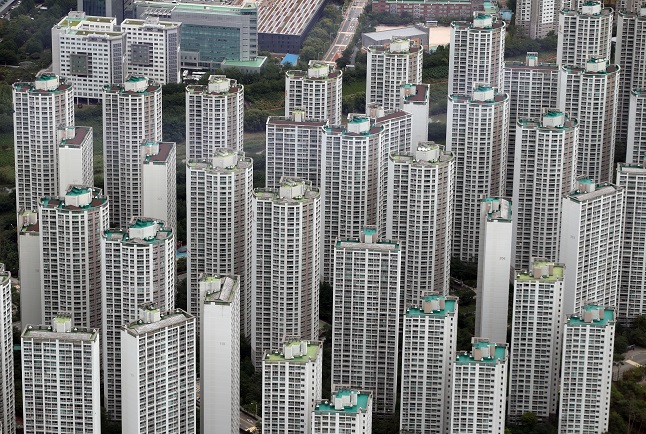
This photo taken on July 15, 2020, shows high-rise apartments in the southeastern Seoul ward of Songpa as seen from an observatory at Lotte Wold Tower, also in Songpa. Songpa is regarded as one of the four southern Seoul wards where housing prices are higher compared with other areas of the capital. (Yonhap)
SEOUL, Dec. 27 (Korea Bizwire) — An increasing number of people are struggling to pay back loans with as interest rates continue to rise, a central bank report said Monday.
The Bank of Korea (BOK) reported that the average debt service ratio (DSR) of mortgage borrowers in the third quarter of this year reached 60.6 percent, surpassing the 60 percent hurdle for the first time in almost four years.
As one of the barometers checked to determine risky household loans, DSR measures how much a borrower has to pay in principal and interest payments in proportion to his or her yearly income.
The DSR of mortgage and credit loan borrowers rose from 64.6 percent in June of last year to 69.2 percent in September of this year.
Normally, a higher DSR undermines the ability of borrowers to pay back their loans, resulting in a higher delinquency rate, which may pose a risk to the entire financial market.
If DSR exceeds 70 percent, the borrower is deemed incapable of paying back the principal and interest, excluding minimum living expenses from income.
People who have taken out mortgages and credit loans may already be facing issues paying back the principal and interest.
“Any impact that would undermine the income or credit of a non-vulnerable borrower may result in the increase of the proportion of vulnerable borrowers,” the BOK said.
The proportion of vulnerable borrowers, which includes low-income, low-credit borrowers of multiple loans, stood at 6.32 percent as of the third quarter of this year.
“It was found that approximately 1.8 percent of non-vulnerable borrowers became vulnerable borrowers in the second to fourth quarters of 2016 and the second to fourth quarters of 2017 when rising interest rates and the situation of the real estate market was similar to today,” the BOK added.
“The proportion of vulnerable borrowers may exceed 8 percent, depending on internal and external conditions.”
H. M. Kang (hmkang@koreabizwire.com)






